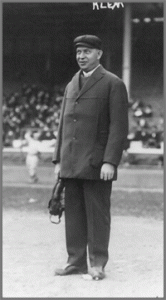History of Umpiring
By:
From the creation of the modern game in the 1840s through the Civil War, the umpire was the personification of base ball (two words then) as an amateur sport played by gentlemen. According to the September 23, 1845, rules of the Knickerbocker Club of New York, which created modern baseball, the president of the club "shall appoint an Umpire, who shall keep the game in a book provided for that purpose, and note all violations of the Bylaws and Rules." As "match" games between clubs became more frequent, three officials were commonly used--one umpire chosen by each team and a neutral "referee" to decide the often partisan split decisions. In 1858 the National Association of Base Ball Players sanctioned a single umpire, sometimes a spectator or even a player, chosen by the home team with the consent of the rival captain.
There was no dress code, but contemporary prints depict the idealized portrait of the gentleman arbiter--a distinguished-looking gentleman resplendent in top hat, Prince Albert coat, and cane, who stood, kneeled, or sat on a stool in foul territory along the first base line. Although the attire became less formal by the Civil War, the volunteer arbiters continued to receive no remuneration for their services other than the "honor" of being chosen "the sole judge of fair and unfair play."
The nationwide popularity of the game after the Civil War led to the professionalization of baseball and, in turn, to professional umpires. In 1871 the newly formed National Association of Professional Base Ball Players continued the tradition of unpaid volunteers by allowing the home team to choose the umpire from a list of five names submitted by the visiting club, but gave the arbiter greater authority by limiting appeals to decisions involving rules interpretation, not judgment. In 1878 the National League of Professional Base Ball Clubs, organized two years earlier, instructed home teams to pay umpires $5 per game, and in 1879 National League president William A. Hulbert appointed baseball's first umpire staff--a group of twenty men from which teams could chose an arbiter. The approved list and compensation did not free the umpires from the "homer" syndrome (ruling in favor of the home team as a civic gesture) or suspicion of collusion with gamblers. Indeed, in 1882 Richard Higham of Troy, New York, former manager and National League player, was banished from the league for advising gamblers how to bet on games he umpired, thus earning the infamous distinction of being the only umpire ever judged guilty of dishonesty on the field.
